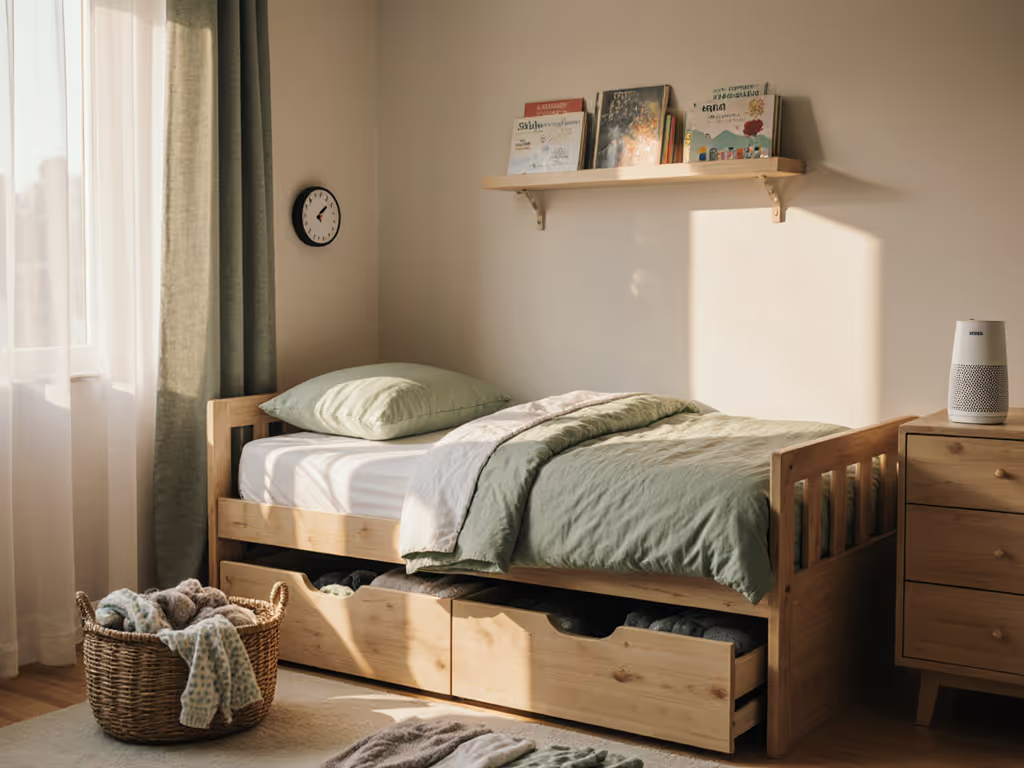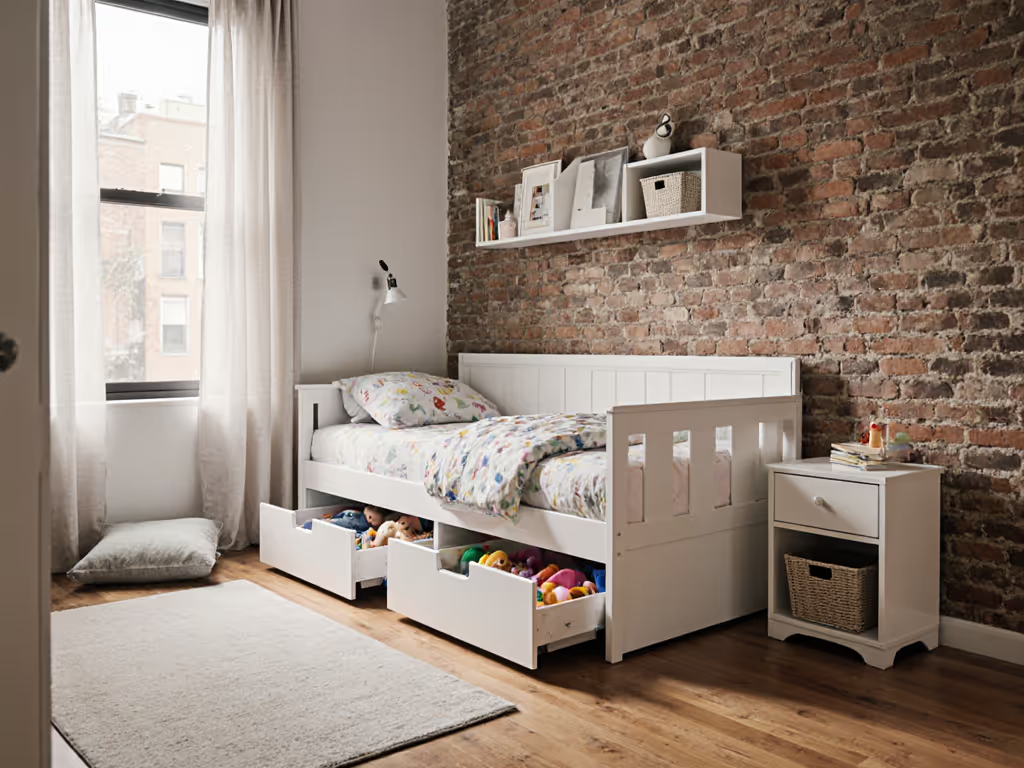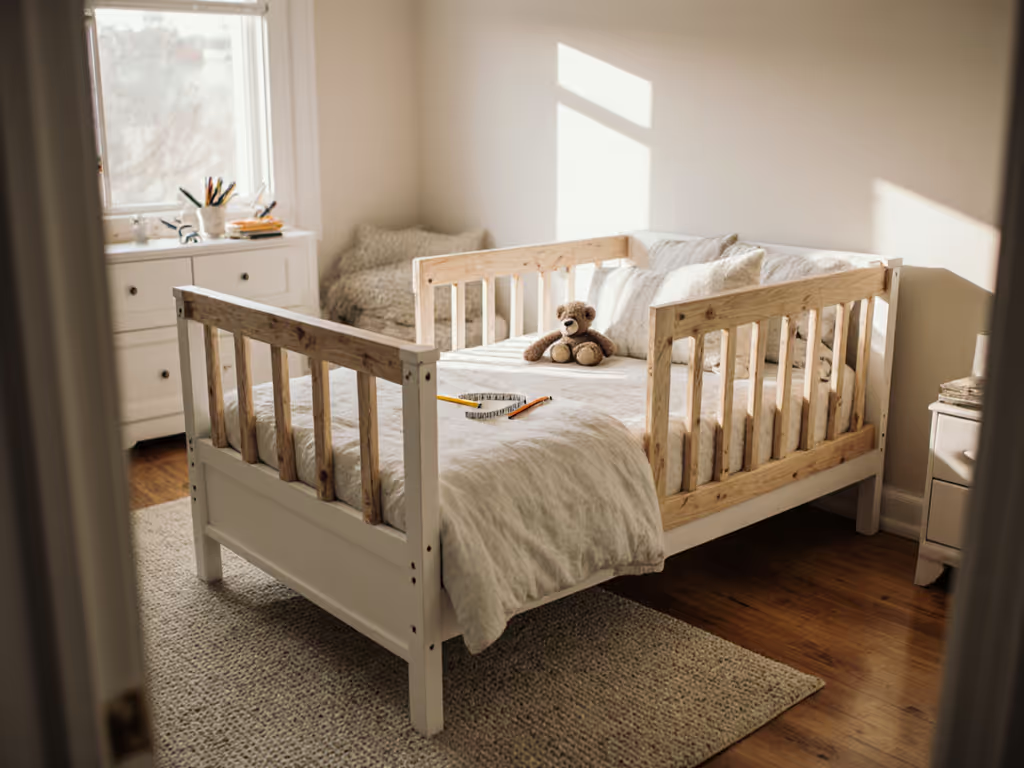
Adjust Your Toddler Bed for Seasonal Sleep Safety

As a parent educator who's helped hundreds of families navigate the transition from crib to bed, I've seen how seasonal toddler bed adjustments can transform restless nights into peaceful sleep. That temperature-regulated toddler sleep isn't just comfortable, it's essential for safety and development. When our daughter began staging nightly protests, we realized her environment wasn't supporting her natural rhythms. By lowering her world and understanding how temperature affects sleep, we created a space where she felt safe year-round. Small changes in space, big changes in sleep, especially when seasons shift.
Understanding Temperature Needs for Toddler Sleep
The Science Behind Sleep Temperature
Toddlers thrive in environments that support their developing ability to regulate body temperature. While infants require more precise temperature control due to immature thermoregulation systems, toddlers still need careful attention to their sleep environment. Research shows the ideal temperature range for toddler sleep falls between 64°F and 68°F (18°C to 20°C), though some sources suggest up to 72°F (22°C) may be acceptable with proper clothing.
When room temperature drifts outside this range, sleep quality suffers. Too warm, and your child may experience restless sleep, frequent waking, and night sweats. Too cold, and they may struggle to stay asleep as they expend energy trying to stay warm. The connection between temperature and sleep is profound. Our body's natural cooling process is essential for entering and maintaining deep sleep cycles. For routines that support this cooling process, see our evidence-based bedtime routine guide.
Recognizing When Temperature Is Affecting Sleep
"Gentle transitions in environment support gentle transitions in sleep."
Watch for these subtle signs that your toddler's sleep environment may be too warm or too cool:
- Too hot: Restless sleep, damp hair or pajamas, flushed skin, kicking off blankets, frequent waking
- Too cold: Curling into a tight ball, shivering (subtle), seeking extra blankets or climbing into your bed
These cues matter more than thermometer readings alone. I've worked with families who maintained "perfect" room temperatures yet struggled with sleep because their child's specific needs weren't being met. Your toddler's sleep space should support their natural rhythms, not fight against them.
Summer Toddler Bed Adjustments: A Step-by-Step Guide
Step 1: Simplify Bedding for Breathability
Switch out thick winter bedding for lightweight, breathable options. Opt for a single cotton sheet or a lightweight sleep sack with a lower TOG rating (0.5 TOG is ideal for summer). Avoid heavy comforters that can trap heat (remember, your toddler needs to be able to regulate their temperature throughout the night). If your child tends to run hot, consider temperature-regulating mattress pads or breathable protectors to improve airflow.
Step 2: Adjust Clothing Choices
Choose moisture-wicking pajamas made from natural fibers like cotton or bamboo. Sleeveless options work well in extremely hot climates, but avoid bare skin which can lead to chills if the AC cycles on overnight. A onesie underneath offers temperature flexibility (you can remove the top layer if they get too warm).
Step 3: Optimize Room Environment
Position your toddler's bed away from direct sunlight and heat sources. Use light-colored window treatments that block heat while allowing natural light during the day. Consider a fan circulating air (not directly on your child) to create a gentle breeze that helps evaporate sweat and maintain comfortable temperatures.
Step 4: Create a Summer-Specific Wind-Down Corner
Establish a summer toddler bed setup that supports cooling down before sleep. A small bowl of cool water for hand-dipping or a damp washcloth for the forehead can help lower body temperature naturally. Keep their space minimal (remove any decorative pillows or stuffed animals that trap heat). Remember, calm is a design choice that starts with temperature awareness.
Winter Toddler Bed Adjustments: A Step-by-Step Guide
Step 1: Layer Strategically
Begin with a fitted cotton sheet as your base layer. Add a mid-weight sleep sack (2.5 TOG is typically appropriate for winter), then offer one additional wearable blanket if needed. The "one extra layer" rule applies here (you should wear one less layer than your toddler needs to be comfortable).
Step 2: Check Bed Placement
Ensure your toddler's bed isn't positioned near cold drafts from windows or doors. In our small-space apartment, we moved our daughter's floor bed slightly away from the exterior wall during winter months (a simple spatial tweak that made a noticeable difference in her comfort). If you're using a low Montessori bed, here’s how to balance independence with fall prevention through smart setup. This is where your winter toddler bedding setup meets practical room arrangement.
Step 3: Manage Humidity Levels
Dry winter air can make rooms feel colder than they are. A humidifier set to 40-60% humidity not only helps prevent dry skin and respiratory issues but also makes the room feel warmer at lower temperatures. This subtle environmental shift supports better sleep without overheating concerns.
Step 4: Establish Predictable Cues for Cold Nights
Create a consistent pre-sleep ritual that includes warming up (perhaps a warm (not hot) bath 90 minutes before bed, or a cup of warm milk). These predictable cues help signal to your child's body that it's time to prepare for sleep in the cooler environment. Keep their self-serve setup accessible with seasonal pajamas in a low drawer they can reach.
Year-Round Foundations for Seasonal Sleep Safety
Temperature Monitoring Without Dependence
Rather than constantly adjusting the thermostat, teach your toddler to recognize their own comfort level. "I'm too hot/cold" cards by their bed or a simple hand signal empowers them to communicate needs. This self-serve setup builds independence while keeping you informed.
Bedding That Adapts Seamlessly
Invest in quality basics that work across seasons: a well-fitting cotton sheet set and a versatile sleep sack system. Having these core elements creates a foundation for toddler bed climate control that doesn't require complete overhauls with each season change.
Space Optimization for Temperature Flow
In small living spaces, furniture placement dramatically affects air circulation. Keep pathways clear around your toddler's bed to allow for proper airflow. While refining layout, follow our childproofing bedroom guide to anchor furniture and manage cords safely. During summer, this prevents stagnant hot air; in winter, it ensures warm air can circulate evenly. A thoughtful layout creates natural temperature regulation (another example of how calm is a design choice that supports rest).
Your Actionable Next Step
Tonight, before your toddler heads to bed, take just two minutes to assess:
- Place your hand on their chest and back (should feel warm but not sweaty)
- Check if they've kicked off bedding (sign they're too warm) or curled tightly (sign they're too cold)
Make one small adjustment based on what you observe. This simple practice builds your awareness of your child's unique temperature needs and creates a foundation for seasonal sleep safety that evolves with them. Remember, simple access to appropriate bedding invites cooperation (start with just one seasonal tweak this week and notice the difference in their sleep quality). When your toddler's environment supports their natural rhythms, everyone in the household benefits from more restful nights.
Related Articles


Space-Saving Toddler Beds for Small Bedrooms: Top 5 Picks
Create a calm, independence-boosting sleep space in a small room with low-profile design guidance, exact measuring tips, and renter-friendly considerations. Compare five compact toddler beds selected to maximize floor space, safety, and flexibility - even in shared or oddly shaped rooms.

Toddler Storage Beds: Safe Low Heights for Tiny Rooms
Choose small-space toddler beds that balance fall safety, usable storage, and clean air with a minimum 7-inch clearance, verified VOC certifications, and solid-wood options. Get practical alternatives to under-bed drawers plus a simple off-gassing and monitoring plan for healthier sleep in tight rooms.

Toddler Bed Bundles: Complete Sets for Maximized Space
Choose toddler bed bundles that truly fit tight rooms: verify dimensions, favor low-profile frames with usable under-bed storage, and stick to crib-sized mattresses to keep clear paths. A simple checklist and common pitfalls help ensure every square inch serves sleep or storage.

